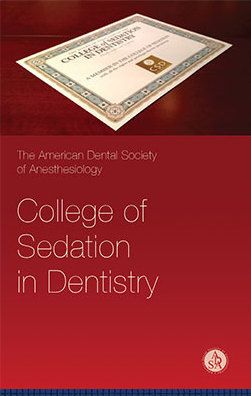
College of Sedation in Dentistry
Anesthesia is an integral component of dentistry. Dentists can provide anxiety-free dental care using numerous sedative techniques obtained through advanced education. The ADSA is the organization that represents and respects all dental anesthesia providers across the entire spectrum of anesthesia and pain control in dentistry. Therefore, the American Dental Society of Anesthesiology (ADSA) established the College of Sedation in Dentistry in 2001 to provide for recognition of ADSA members who have demonstrated excellence through advanced training in sedation for dentistry and who are committed to safe and effective patient care.
Admission to the college demonstrates to the public your commitment to offering high quality, safe and effective sedation care to your patients. Achieving Membership or Mastership status in the ADSA College of Sedation in Dentistry will further ensure dentistry's ability to continue to provide high quality sedation care well into the future.
The Examination is administered at all ADSA Meetings throughout the year.
Parenteral Requirements (MASTERSHIP)
In order to achieve MASTERSHIP of the College of Sedation in Dentistry an individual must:
1. Successfully complete of an approved course of study in parenteral dental sedation, as described in the American Dental Association’s Guidelines for Teaching the Comprehensive Control of Anxiety And Pain In Dentistry, Teaching the Comprehensive Control of Anxiety and Pain in a Continuing Education Program; or possession of a valid state permit or its equivalent certifying that the individual may administer parenteral dental sedation.
2. Document that the candidate has successfully completed forty (40) hours of approved, continuing education in dental sedation and/or dental anesthesiology, and has successfully completed a course in Advanced Cardiac Life Support (ACLS) or its equivalent.
3. Successfully complete the MASTERSHIP Examination for Sedation in Dentistry of the American Dental Society of Anesthesiology.
4. Become a member of the American Dental Society of Anesthesiology.
In addition, in order to maintain Mastership of the College of Sedation in Dentistry the individual shall be required to document that he/she has successfully completed fifteen (15) hours of approved, continuing education in dental sedation and/or dental anesthesiology every two (2) years in addition to successfully completing training in Advanced Cardiac Life Support (ACLS) or its equivalent every two (2) years.
The Examination is administered at ADSA meetings throughout the year.
The examination is a multiple-choice examination that covers all aspects of dental sedation. The examination is administered over a two hour time period at the end of each meeting. The examination is not limited to these areas but the following areas are emphasized within the examination:
a) Medical evaluation
b) Pharmacology
c) Perioperative care
d) Anesthetic technique
e) Anesthetic pharmacology
f) Recognition and management of anesthetic emergencies and complications
While the examinee must command a solid foundation of sedation knowledge the society recommends the following texts as primary references:
a) Malamed SF Sedation: A guide to patient management.
b) Dionne, Phero, Becker: Management of Pain and Anxiety in the Dental Office.
ADSA members have consistently sought further education and knowledge in this important aspect of dental care. Opportunities for such further training are provided by the numerous courses that the ADSA provides.
Enteral Requirements (MEMBERSHIP)
In order to acheive MEMBERSHIP of the College of Sedation in Dentistry an individual must:
1. Successfully complete an approved course of study in enteral and/or combination inhalation-enteral dental sedation (combined dental sedation) as described in the American Dental Association’s Guidelines for Teaching the Comprehensive Control of Anxiety And Pain In Dentistry, Teaching the Comprehensive Control of Anxiety and Pain in a Continuing Education Program; or possession of a valid state permit or its equivalent certifying that the individual may administer enteral and/or combination inhalation-enteral dental sedation (combined dental sedation).
2. Produce documentation that the candidate has successfully completed eighteen (18) hours of approved, continuing education in dental sedation and/or dental anesthesiology, and has successfully completed a course in Basic Cardiac Life Support for Healthcare Providers (BLS-HCP) or its equivalent.
3. Become a member of the American Dental Society of Anesthesiology.
4. Successfully complete the Membership Examination for Sedation in Dentistry of the American Dental Society of Anesthesiology.
In addition, in order to maintain Membership of the College of Sedation in Dentistry the individual shall be required to document that he/she has successfully completed twelve (12) hours of approved, continuing education in dental sedation and/or dental anesthesiology every two (2) years in addition to successfully completing training in Basic Life Support for Healthcare Providers (BLS-HCP) every two (2) years. Advanced Cardiac Life Support (ACLS), while desirable, is in addition to this requirement.
The Examination is administered at ADSA meetings throughout the year.
The examination is a multiple-choice examination that covers all aspects of dental sedation. The examination is administered over a two hour time period at the end of each meeting. The examination is not limited to these areas but the following areas are emphasized within the examination:
a) Medical evaluation
b) Pharmacology
c) Perioperative care
d) Anesthetic technique
e) Anesthetic pharmacology
f) Recognition and management of anesthetic emergencies and complications
While the examinee must command a solid foundation of sedation knowledge the society recommends the following texts as primary references:
a) Malamed SF Sedation: A guide to patient management.
b) Dionne, Phero, Becker: Management of Pain and Anxiety in the Dental Office.
ADSA members have consistently sought further education and knowledge in this important aspect of dental care. Opportunities for such further training are provided by the numerous courses that the ADSA provides.




